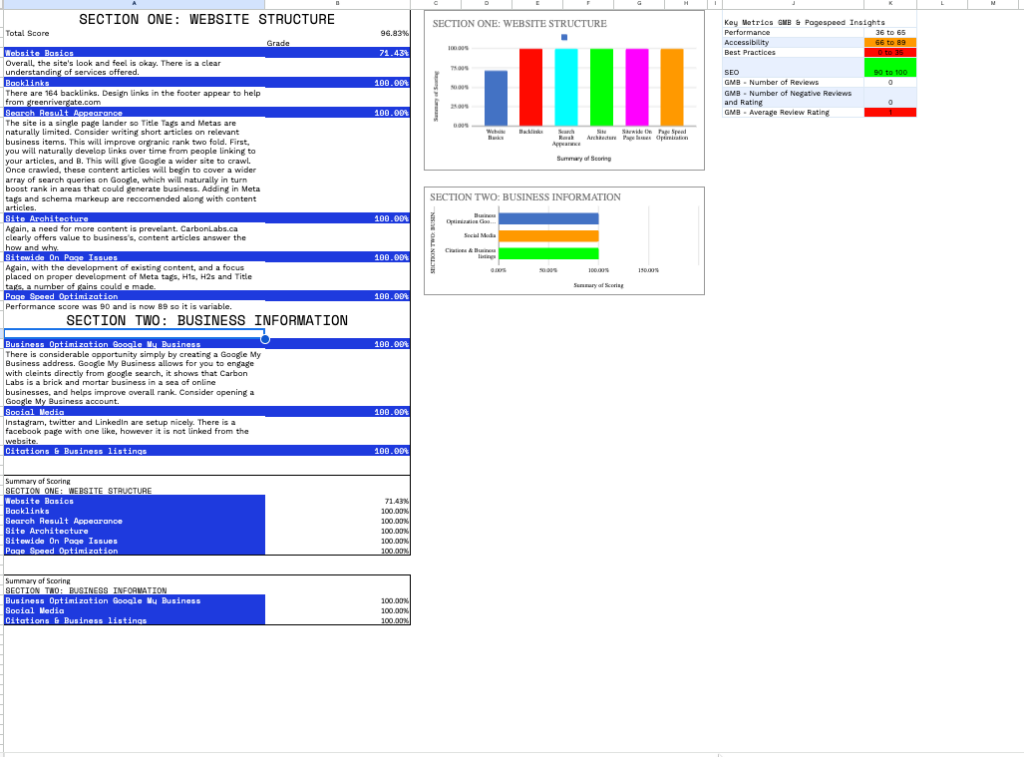Streamline Your Website’s Success with a Website Audit Template
Are you looking for ways to improve your website’s performance and maximize its potential? Look no further than with our high level executive website audit. By conducting a audit of your website, you can identify areas for improvement, optimize your site’s performance, and ultimately increase your online success. But where do you start?
A website audit template is essentially a guide that helps you evaluate your website’s performance, functionality, and design. It is a comprehensive checklist that covers all the essential elements of a successful website. With a pre-designed template, you don’t have to worry about missing any crucial aspects of your website’s evaluation, plus it saves you time and effort. So, let’s take a closer look at how a website audit template can help improve your website’s performance.
Website Audit Template
Serving as a structured and organized checklist that covers various areas of your website. It includes sections for user experience, design, content, SEO, functionality, and more. Each section contains specific tasks that you need to perform during the audit. By following this template, you can easily identify and address any issues or weaknesses on your website. You can also track your progress and stay organized throughout the audit process, making it easier to implement changes and improvements.
You can download our Executive Website Audit Template for free.
This template does not require you to provide any personal information, and we do not collect any emails or other personal details—it’s completely free.
This website audit template serves as a high level guide, outlining critical tasks across various categories. It is meticulously segmented to streamline the review process, with each section dedicated to a core component, such as user experience or SEO. Within, you’ll engage with specific elements like checking for mobile responsiveness or optimizing meta tags. Adhering to this organized approach ensures a thorough evaluation of your site’s overarching functionality and performance.
Please Note
Please note that while this template offers 52 high-level questions providing insights and a general overview of your website’s performance, it is not exhaustive. You do not need access to Google Search Console or any third-party tools to use this template, although having these resources might enhance your understanding. This template is available to anyone interested in assessing their website.
Screenshots from Template




For a thorough audit, please contact us to set up a discovery meeting. Our full audits delve into more complex areas that are not covered in this simple Google Sheet template.
Disclaimer:
The template is provided as-is. Simply answer the questions in the Audit Questions section, and the rest should auto-complete. If you encounter any issues, feel free to email me.
Origins of this Template
I originally developed this template more than five years ago. It was designed as a comprehensive checklist to guide me through the process of evaluating a website when considering a new client. The aim was to systematically review various aspects of a site to ensure thorough analysis and identify key areas for improvement or potential challenges.
This template has since served as a reliable tool for site assessments, facilitating a structured approach to evaluating and understanding the digital presence of potential clients. It covers various dimensions of a website, from technical performance to content quality, ensuring that nothing critical is overlooked.
Feel free to utilize this template for similar purposes. Whether you’re conducting preliminary reviews for prospective clients or simply auditing your own site, this checklist can help streamline the process, making it more efficient and comprehensive. It’s designed to be adaptable to different types of websites and can be customized as needed to fit specific needs or focus areas.
Moreover, this resource is intended to be accessible and user-friendly, requiring no prior setup with specialized tools. However, integrating additional analytics tools can further enhance the depth and accuracy of your site audits. If you find the template useful, I encourage you to adapt it to your workflows and share your experiences or suggestions for improvements.

Audit Website Performance
One of the critical components of a website audit is evaluating its performance. Your website’s performance directly affects user experience and, ultimately, your website’s success. Therefore, it’s crucial to include website performance testing in your audit using tools like Google PageSpeed Insights or GTmetrix. These tools can help identify any issues that may be slowing down your website, such as large image files or outdated plugins. By addressing these issues, you can improve your website’s speed and responsiveness, leading to better user experience and higher search engine rankings.
Here are some FAQs we run into from time to time.
How Do You Organize a Website Audit?
Organizing a website audit can seem like a daunting task, but with a comprehensive website audit template, it becomes much more manageable. The first step is to gather all the necessary information and resources, including your website’s analytics and any previous audits. Next, follow the checklist systematically, ensuring that each task is completed and marked off before moving on to the next. Finally, document your findings and create an action plan for addressing any issues that arise.
What is a Website Audit?
A website audit is a comprehensive evaluation of your website’s performance, design, and functionality. It helps identify any weaknesses or issues that may be hindering your website’s success. By conducting a website audit, you can improve user experience, increase search engine rankings, and ultimately achieve your website’s goals.
How to Do a Design Audit of a Website?
A design audit of your website involves evaluating the visual elements of your site, such as layout, color scheme, images, and typography. A well-designed website is critical for attracting and retaining visitors. Therefore, it’s essential to evaluate if your website design is appealing, user-friendly, and reflective of your brand. Using your audit template, you can check for consistency, responsiveness, and overall visual appeal.

How Do You Audit Website Performance?
As mentioned earlier, website performance is a crucial aspect of a website audit. To audit your website’s performance, you need to evaluate its speed, responsiveness, and overall functionality. By using tools like Google PageSpeed Insights or GTmetrix, *** side note on GTmetrix, they require you to create an account now, so just go straight to pagespeed insights. There you can identify any issues that may be affecting your website’s performance and take steps to address them.
In Conclusion
A comprehensive website audit is an essential step in optimizing your website’s performance and achieving your online goals. By using a our website audit template, you can ensure that no aspect of your website goes unexamined and easily track your progress. So, if you want to streamline your website’s success, don’t underestimate the power of a well-designed audit template.
Learn about the technical aspects of Core Web Vitals, including how they are measured and how improving them can lead to a better user experience, potentially boosting your site’s performance and visibility in search results. We have a comprehensive guide covering the benefits of Core Web Vitals.


